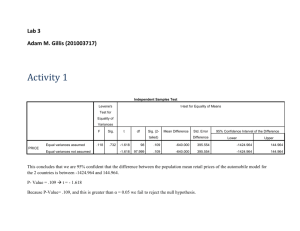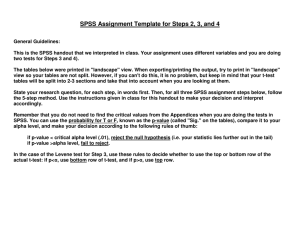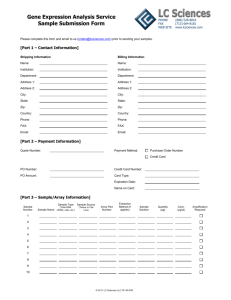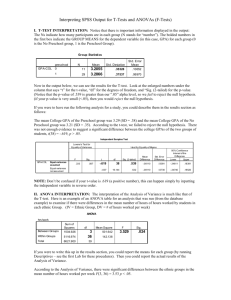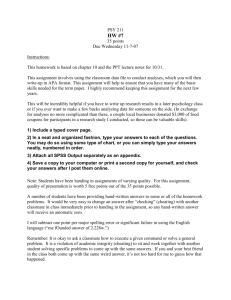SPSS Guide: Tests of Differences
advertisement
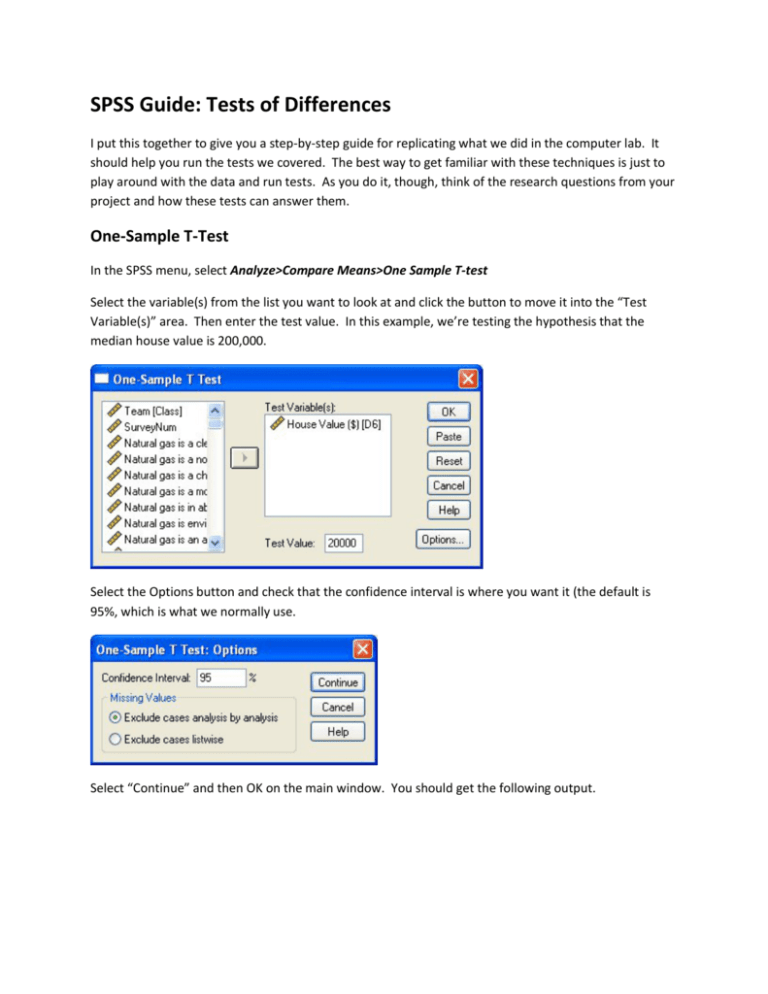
SPSS Guide: Tests of Differences I put this together to give you a step-by-step guide for replicating what we did in the computer lab. It should help you run the tests we covered. The best way to get familiar with these techniques is just to play around with the data and run tests. As you do it, though, think of the research questions from your project and how these tests can answer them. One-Sample T-Test In the SPSS menu, select Analyze>Compare Means>One Sample T-test Select the variable(s) from the list you want to look at and click the button to move it into the “Test Variable(s)” area. Then enter the test value. In this example, we’re testing the hypothesis that the median house value is 200,000. Select the Options button and check that the confidence interval is where you want it (the default is 95%, which is what we normally use. Select “Continue” and then OK on the main window. You should get the following output. One-Sample Statistics N D6 House Value ($) Mean 1123 203786.40 Std. Deviation Std. Error Mean 184926.607 5518.354 One-Sample Test Test Value = 200000 95% Confidence Interval of the Difference t D6 House Value ($) df .686 Sig. (2-tailed) 1122 .493 Mean Difference 3786.401 Lower -7041.05 Upper 14613.85 Note that the mean is $203,786.40, which is pretty close to the hypothesized value. The significance is .493, well above the .05 threshold, so our hypothesis is supported. How do you know whether the significance should be higher or lower than .05? Recall that this is a test of whether there is a statistical difference between the test value and the sample mean. Since the tvalue is not significant, we reject the null hypothesis that there is a difference, and accept our hypothesis. Independent Samples T-test This test is similar to the one-sample test, except rather than testing a hypothesized mean, we’re testing to see if there is a difference between two groups. For the grouping variable, you can choose a demographic trait (such as gender, age, ethnicity, etc) or any other variable that classifies your groups. (In an experimental design, it is a good way to test the differences between the control group and the manipulation group.) In this example, we’ll use gender. In the SPSS menu, select Analyze>Compare Means>Independent Samples T-test Select your Test variable from the list. This is the variable for which you want to compare means. In this example, we will test C18 (“I would describe myself as environmentally responsible.”) Now select the grouping variable, which is the trait you’re using to divide the groups. For this example, we will select gender. Select it from the list and click the arrow next to “Grouping Variable.” Then, click “Define Groups …” and enter the values for the two groups. In this example, 1=Female and 2=Male. Also notice the “Cut Point” option. What if we wanted to divide the sample into two groups based on home value? The cut point would be the value where you split the sample. For example, if you entered 100,000, it would create two groups – one for home value less than 100,000 and another for more than 200,000. For this example, let’s stick to gender, though. Select continue, and then click “OK.” You’ll go back to the previous window with the groups fiilled in. Select “OK”, and you’ll get the output on the following page. You’ll notice that the means appear to be pretty close and the standard deviations are pretty close, too. So the means and distribution don’t appear to be different, but we need to test it statistically. This one is similar to the one-sample test, except first we have to test for equal variance. Step One: Is there a difference in variance? If the Laverne’s Test is <.05, we assume unequal variances and go to the second line. Otherwise, variances are equal, so we use the top test. Step Two: Is there a difference in means? If the significance of the t-test is <.05, there is a difference in means. If it is >.05, then the null hypothesis (no difference) is supported. Group Statistics D1 Gender N C18 I would describe myself 1 Male as environmentally 2 Female responsible Mean Std. Deviation Std. Error Mean 886 3.32 .963 .032 782 3.38 .957 .034 Independent Samples Test Levene's Test for Equality of Variances t-test for Equality of Means 95% Confidence Interval of the F C18 I would describe Equal myself as variances environmentally assumed responsible .021 Sig. t df Sig. (2- Mean Std. Error tailed) Difference Difference Difference Lower Upper .886 -1.248 1666 .212 -.059 .047 -.151 .034 -1.249 1642.573 .212 -.059 .047 -.151 .034 Equal variances not assumed The Laverne’s test of .886 indicates that we should assume equal variances. The t-test significance is .212, so there does not appear to be a difference in means. The null hypothesis is supported. Paired Samples t-test With the paired samples t-test, we’re not testing for differences between groups. Instead, we’re testing for means of different variables within the sample sample. For example, we want to compare the mean for user-created videos and the mean for companygenerated videos. Go to Analyze>Compare Means>Paired Samples T-test Select the two variables you want to compare, and click the arrow to move them into the “Paired Variables” pane. Under options, make sure that you’re using a 95% confidence interval. Click continue and then OK and you’ll get the following output. Paired Samples Statistics Mean Pair 1 N Std. Error Mean Std. Deviation C4 I like YouTube videos created by the sponsor company of the product or brand 2.90 1274 1.191 .033 C5 I like YouTube videos created by customers/fans of the product or brand 3.05 1274 1.183 .033 Paired Samples Correlations N Pair 1 C4 I like YouTube videos created by the sponsor company of the product or brand & C5 I like YouTube videos created by customers/fans of the product or brand Correlation 1274 Sig. .689 .000 Paired Samples Test Mean Pair 1 C4 I like YouTube videos created by the sponsor company of the product or brand C5 I like YouTube videos created by customers/fans of the product or brand -.146 Paired Differences 95% Confidence Interval of the Difference Std. Std. Error Deviation Mean Upper Lower .936 .026 -.197 -.095 Sig. (2tailed) Std. Err or Me Std. Deviation an df t -5.568 1273 .000 Remember that the null hypothesis is that there is no difference between the means. Note that the absolute value of the t-value is greater than the critical value (1.96). Since the significance is .000, which is less than .05 we can reject the null hypothesis and conclude that there is a difference between the two means. If you look at the descriptive statistics for the paired sample, you can see which mean is greater. One-Way ANOVA What if we want to test for differences between more than two groups. ANOVA (which stands for “Analysis of Variance”) is the way to go. Analysis>Compare Means>One-Way ANOVA Select the variable(s) you want to test and move into the “Dependent List” pane. Now, move the variable that you are using to separate them into groups into the “Factor” pane. For example, in our data set, there are three age groups (“1”,”2” and “3”) for the 15-18, 19-24, and 25+ groups, respectively, in the AgeGroup variable. Click “OK” and you get the following output. ANOVA CON1 Sum of Squares Between Groups df Mean Square 2.707 2 1.353 Within Groups 1081.801 1282 .844 Total 1084.508 1284 F 1.604 Sig. .202 The F-test is less than the critical F-value (1.604<1.96). The significance of .202 is greater than .05, so we fail to reject the null. There are no significant differences in the mean for CON1 between the three groups. The test is complete. But what if the test is significant? ANOVA CON2 Sum of Squares Between Groups df Mean Square 21.145 2 10.572 Within Groups 931.955 1286 .725 Total 953.100 1288 F 14.589 Sig. .000 The significance is .000, so we reject the null hypothesis and conclude that at least one of the means is significantly different. But which one(s)? To determine this, we must use a post-hoc test. Go back to Analyze>Compare Means>One Way ANOVA but this time, click Post-Hoc Then, select “Tukey” and “Duncan” You will get the following output for the Tukey test. Post Hoc Tests Multiple Comparisons Dependent Variable:CON2 95% Confidence Interval Tukey (I) AgeGroup (J) AgeGroup AgeGroup AgeGroup 1 15-18 year olds 2 19-24 year olds .00831 .05820 .989 -.1282 .1449 3 25 years old + .27527 * .05816 .000 .1388 .4117 1 15-18 year olds -.00831 .05820 .989 -.1449 .1282 3 25 years old + .26696 * .05789 .000 .1311 .4028 1 15-18 year olds -.27527 * .05816 .000 -.4117 -.1388 2 19-24 year olds -.26696 * .05789 .000 -.4028 -.1311 HSD 2 19-24 year olds 3 25 years old + *. The mean difference is significant at the 0.05 level. Mean Difference (I- Std. J) Error Sig. Lower Upper Bound Bound Notice that the output compares the group in the left column with the other two groups in the right column and gives you the significance level and the difference in means. The 25 year old + group is significantly different (p=.000) than the other two groups, but there is no significant difference between the 15-18 year olds and 19-24 year olds. The” mean difference” column indicates that I-J = .27527); that is, the mean for 15-18 year-olds – mean for 25yo + = .27527. In other words, the mean for 15-18 year olds is .27527 higher (on a 1-5 scale) than the 25+ yo. Also, the Duncan and Tukey tests both create homogenous groups (“segments”, in strategy terms) based on their means. CON2 Subset for alpha = 0.05 AgeGroup AgeGroup a Tukey HSD N 1 3 25 years old + 433 2 19-24 year olds 432 3.6079 1 15-18 year olds 424 3.6162 Sig. Duncan a 2 3.3409 1.000 .989 3 25 years old + 433 2 19-24 year olds 432 3.6079 1 15-18 year olds 424 3.6162 Sig. 3.3409 1.000 .886 Means for groups in homogeneous subsets are displayed. a. Uses Harmonic Mean Sample Size = 429.629. As you would expect from the previous test, the 25+ group forms one segment and the other two age groups form a second segment. The values (3.3409, etc.) are the means for each group.
